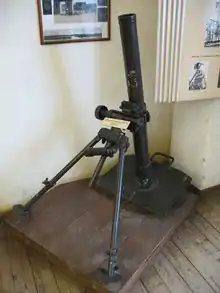8 cm Granatwerfer 34
The 8 cm Granatwerfer 34 (8 cm GrW 34) was the standard German infantry mortar throughout World War II.[4] It was noted for its accuracy and rapid rate of fire.
| 8 cm Granatwerfer 34 | |
|---|---|
 A GrW 34 at the Festung Hohensalzburg | |
| Type | Mortar |
| Place of origin | Nazi Germany |
| Service history | |
| In service | 1937–1952 |
| Used by | Nazi Germany East Germany Bulgaria Yugoslavian Partisans[1] |
| Wars | World War II |
| Production history | |
| Designer | Rheinmetall |
| Designed | 1932–1934 |
| Unit cost | 810 Reichsmark |
| Produced | 1934–1945 |
| No. built | 75,255[2] |
| Variants | 8 cm GrW 34/1 |
| Specifications | |
| Mass | 62 kg (136.6 lbs) steel barrel 57 kg (125.6 lbs) alloy barrel |
| Barrel length | 1.14 m (3 ft 9 in)[3] |
| Shell | 3.5 kg (7 lb 11 oz) |
| Caliber | 81.4 mm (3.20 in) |
| Elevation | 45° to 90° |
| Traverse | 10° to 23°[3] |
| Rate of fire | 15-25 rpm |
| Muzzle velocity | 174 m/s (571 ft/s) |
| Effective firing range | 400–1,200 m (440–1,310 yd) |
| Maximum firing range | 2.4 km (1.5 mi)[3] |
History
.jpg.webp)
The weapon was of conventional design and broke down into three loads (smooth bore barrel, bipod, baseplate) for transport.[4] Attached to the bipod were a traversing handwheel and a cross-leveling handwheel below the elevating mechanism.[5] A panoramic sight was mounted on the traversing mechanism yoke for fine adjustments. A line on the tube could be used for rough laying.[6]
The 8 cm GrW 34/1 was an adaptation for use in self-propelled mountings. A lightened version with a shorter barrel was put into production as the kurzer 8 cm Granatwerfer 42.
The mortar employed conventional 8 cm 3.5 kg shells (high explosive or smoke) with percussion fuzes. The range could be extended by fitting up to three additional powder charges between the shell tailfins.[6]
A total of 74,336,000 rounds of ammunition were produced for the Granatwerfer 34 from September 1939 to March 1945.[2]
Ammunition
List of available ammunition for the Granatwerfer 34.[7]
| Name | Caliber | Mass of explosive material | Target effect | Other information |
|---|---|---|---|---|
| Wurfgranate 34 (Mortar grenade 34) |
80,7 mm | 533 g | Blast and shrapnel effect | |
| Wurfgranate 34 Blauring (Mortar grenade 34 bluering) |
530 g | Blast, shrapnel and chemical effect | Chemical agent: Adamsite | |
| Wurfgranate 34 Ex (Mortar grenade 34 dummy) |
0 g | None (training ammunition) | Ammunition used for learning general handling | |
| Wurfgranate 34 Nb (Mortar grenade 34 smoke) |
500 g | Smoke effect | Effect load: Sulfur trioxide in pumice stone | |
| Wurfgranate 34 Üb (Mortar grenade 34 training) |
57 g | Minimal blast effect | Training ammunition | |
| Wurfgranate 34 Weißring (Mortar grenade 34 whitering) |
550 g | Blast, shrapnel and chemical effect | Chemical agent: Phenacyl chloride | |
| Wurfgranate 38 (Mortar grenade 38) |
400 g | Blast and shrapnel effect | ||
| Wurfgranate 38 Deut (Mortar grenade 38) |
200 g | Ejection charge | ||
| Wurfgranate 38 umg (Mortar grenade 38 rebuild) |
550 g | Blast and shrapnel effect | ||
| Wurfgranate 39 (Mortar grenade 39) |
400 g | Blast and shrapnel effect | ||
| Wurfgranate 40 (Mortar grenade 40) |
80,9 mm | 2000 g | Blast and shrapnel effect | |
| Wurfgranate 40 Üb (Mortar grenade 40 training) |
0 g | None | Training ammunition | |
See also
Weapons of comparable role, performance and era
- Brandt Mle 27/31 original French mortar design of the 1920s, after which all 3″/8 cm/81.4 mm/82 mm mortars of the Second World War era were patterned
- Ordnance ML 3 inch Mortar British equivalent
- M1 mortar US equivalent
Citations
- Vukšić, Velimir (July 2003). Tito's partisans 1941–45. Warrior 73. Osprey Publishing. pp. 25, 61. ISBN 978-1-84176-675-1.
- (in German)
- Chamberlain, Peter (1975). Mortars and rockets. Gander, Terry. New York: Arco Pub. Co. ISBN 0668038179. OCLC 2067459.
- German Infantry Weapons. United States War Department. May 25, 1943. p. 102.
- German Infantry Weapons. United States War Department. May 25, 1943. pp. 103–104.
- US War Department, Military Intelligence Service; Special series no. 14 (May 25, 1943). German Infantry Weapons. Washington: US Government Printing Office. pp. 102–112.
{{cite book}}: CS1 maint: multiple names: authors list (link) - Database of the Dresdner Sprengschule GmbH
General sources
- Gander, Terry and Chamberlain, Peter. Weapons of the Third Reich: An Encyclopedic Survey of All Small Arms, Artillery and Special Weapons of the German Land Forces 1939–1945. New York: Doubleday, 1979 ISBN 0-385-15090-3